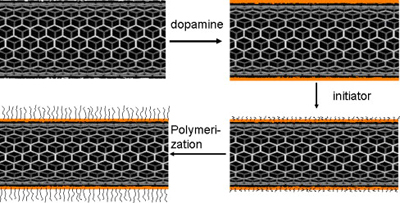New progress in the surface modification of carbon nanotubes (CNTs) was made by researchers of the State Key Laboratory of Solid Lubrication. They have demonstrated an approach to achieve the surface modification of CNTs with a uniform polymer layer mediated by a polydopamine (Pdop) layer.
The synthetic strategy did not ruin the nanotube sidewalls, but rather it realized the multiple functionalities of CNTs, including switchable solubility and electrocatalysis. Pdop coating can serve as a versatile platform for secondary surface-mediated reactions, ultimately leading to the SI-ATRP of functional monomers. Polydimethylamino-ethyl methacrylate (PDMAEMA) and quaternized-PDMAEMA (Q-PDMAEMA) on the CNT surface showed a pH and anion responsive behavior characterized by dispersibility in different external environments. Pd nanoparticles in CNT@Q-PDMAEMA/Pd exhibited high electrocatalytic activity for the oxidation of MeOH and NH2–NH2·H2SO4.
The present approach in this study represents a key addition to the modification of CNTs with either a polymer layer or diverse metal nanoparticles. It can be used to prepare a variety of metal and semiconductor particles/polymer on the surface of CNTs for catalysis applications and for fabricating electronic devices.
The work was published in CARBON (CARBON 48 (2010) 2347–2353).

Depiction of CNT modification with Pdop and polymer brushes


